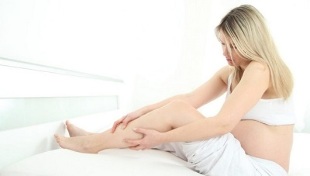Varicose veins are diseases that quickly become chronic. The disease causes changes in the length and diameter of the veins, the formation of nodules, thinning of the venous walls. Quite often, varicose veins are manifested during pregnancy, when a woman's body has significant loads against the background of hormonal changes.
Appearance reasons

Considering the causes of varicose veins during pregnancy, there are several main ones:
- Weight change.During pregnancy, veins appear in the legs due to an increase in weight of ten kilograms or more, which leads to an increase in pressure and load on the vessels;
- Hormonal changes in the body.During fetal formation, a woman's hormonal background is restored, which damages the vessels - they lose elasticity, become fragile, prone to the appearance of varicose veins;
During pregnancy, veins appear in the legs due to weight gain of ten kilograms or more.
- The function of the venous valves changes during pregnancy, with an increase in the volume of blood circulation. It should be noted that varicose veins will disappear nowhere after pregnancy if left untreated;
- Hereditary factors. If one of the parents of a pregnant woman has varicose veins, the chances of developing the same disease are high;
- Choose the wrong clothes and shoes. Sometimes expectant mothers wonder where the varicose veins came from, so do not think that tight clothing and high-heeled shoes can provoke this;
- Reduce physical activity. Blood stagnation in the veins of the legs during pregnancy can begin if a pregnant woman moves slightly and does not do special exercises.
Some of the causes of varicose veins during pregnancy can be easily eliminated - just change your habits.
Symptoms and Signs
Varicose veins during pregnancy are difficult to diagnose at an early stage because there are no pronounced symptoms.

However, it is worth contacting your doctor if you have any of the following symptoms:
- feeling of heaviness and pain in the legs;
- Swelling, especially in the evening if you sit for a long time;
- Convulsions, especially at night;
- redness or darkening of the skin; the appearance of
- vascular networks;
- printed on the skin, the appearance of trophic ulcers;
- Inflammatory veins are easily felt during pregnancy.
Types of varicose veins during pregnancy
Varicose veins during pregnancy can be of several types. The most common disease is:
- in the womb;
- feet;
- in the vagina;
- in the womb.
The appearance of varicose veins in the small pelvis has symptoms similar to some gynecological diseases, so it is the most difficult to diagnose. With each pregnancy, the risk of varicose veins on the labia also increases (symptoms are most felt after exercise or sexual intercourse).
Diagnostics
Varicose veins and pregnancy have a major impact on a woman’s body, causing additional stress on many bodies, so it is important to diagnose the disease at an early stage.
To diagnose varicose veins in pregnant women, the method of duplex sonography is used today. This modern type of diagnosis has replaced previously performed ultrasound angioscanning and Doppler mapping. Duplex sonography is performed for twenty minutes and provides detailed information on the condition of both deep and superficial veins.
In some cases, for additional diagnosis, do the following:
- Segmental Doppler.A simple but reliable test that indicates the condition of arteries confirms their conduction and narrowing.
- BMR (magnetic resonance imaging). If varicose veins are diagnosed during pregnancy, this test allows you to assess the condition of the blood vessels without the use of contrast, it does not cause any harm to the body.
- Computed tomographic phlebography.It is done using contrast, allowing you to assess the condition of ships at great depths. If the varicose veins have vague symptoms, this type of examination is prescribed.

Methods of treating the disease
Not all methods that can treat varicose veins can be used during gestation. For example, during pregnancy, injections of certain medications may not be used; Surgery is not always possible. These restrictions also apply to women with varicose veins in the legs, but plan to become pregnant within the next two years.
Surgical treatment
As mentioned earlier, varicose veins are dangerous during pregnancy due to the limited treatment options. However, there are situations when drug treatment is not enough, then surgery is performed. For example, if acute thrombophlebitis is present or there are curative trophic ulcers.
In most cases, surgeries are performed at gestational age not more than six months and sclerotherapy or frequency ablation is used, followed by subsequent surgeries after pregnancy. Special underwear and therapeutic exercises are prescribed in the postoperative period - these recommendations apply to the postpartum period.
Today, if acute varicose veins are detected during pregnancy, they use laser treatment instead of a scalpel. Modern technology allows you to quickly and safely defeat varicose veins.
Medications
Doctors are well aware of the dangers of varicose veins, so they recommend specialists at the first sign of the disease. In such a situation a course of venotonic drugs and means of normalizing blood density are prescribed. There is also a selection of special ointments and large gels for external use, including those containing ginkgo biloba. Any medication that affects venous tone is serious, so they should only be taken according to the regimen recommended by your doctor.
Alternative treatment
People have long been dealing with the "pregnancy and varicose veins" in tandem, so in the past and today in the treatment of such folk methods as lotions, tinctures, ointments, baths are widely used. Of course, if the disease is neglected, then this technique is considered only as adjunctive therapy, but at an early stage alternative treatment is quite effective.
Compress the tincture:

- During the initial stages of varicose veins during steam, we will overcome the sweat well. You need to take 1 tablespoon of cones, pour 200 ml of boiling water and keep for 20 minutes. After that, the solution is strained and used for compresses. Similarly, infusions are made from horse chestnut flowers or leaves. Such compresses can be used at night and kept on the feet until morning.
- During pregnancy, the veins are treated with a powder purified from horse chestnut fruit: 50 grams of this powder is poured into 200 ml of vegetable oil and the legs are carried out with the composed composition before going to bed;
- If early varicose veins are detected during pregnancy, the burning leaves of cabbage use compresses that relieve inflammation, pain, swelling.
Varicose veins on the legs during pregnancy are recommended by means of infusion cells of various medicinal plants, the choice of which is quite wide in all pharmacies. It is recommended to do this:
- The temperature of the solution in the bath should not exceed 38 degrees;
- Take baths for no more than 15 minutes;
- After the procedure, do a relaxing massage;
- Lie on your feet at the end of the bath for 30-40 minutes.
Varicose veins in pregnant women are also treated with herbal decoctions taken orally:
- Prepare meadow clover flowers: Pour 1 tablespoon of chopped flowers in a thermos and pour 400 ml of boiling water. After two hours, filter the broth and take ½ cup 4 times a day;
- You can make a collection from kolfut, wild strawberry and link, pentagonal leaves, as well as calendula and viburnum flower leaves. The ingredients are mixed in equal parts, the resulting mixture is poured into 2 tablespoons of 400 ml of boiling water and kept for 15 minutes in a water bath. After that, you need to hold the collection for 40 minutes in a warm place. Take ½ cup 4 times a day.
Disease Prevention
Varicose veins in the legs, like any disease, should not only be treated, but preventive measures should be taken to prevent the disease or prevent its recurrence:- It is not recommended to sit or stand for long periods of time. It is advisable to relax on the side to relieve stress from the veins of the legs and small pelvis.
- To relieve the stress on the veins in your legs, raise your legs while standing or sitting.
- Wear special foot pumps to ease the blood vessels in your legs during pregnancy. Such underwear promotes blood flow through the veins, stimulates blood flow in the veins of the legs, and reduces the likelihood of blood clots. Wearing compression jewelry is recommended not only during pregnancy but also after pregnancy, for one and a half or two months.
Remember that varicose veins on the legs are less common in people who exercise and lead a healthy lifestyle. Even light exercise helps maintain physical fitness and reduce the risk of developing varicose veins.




































